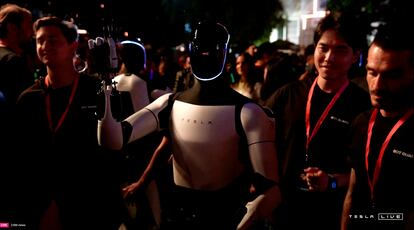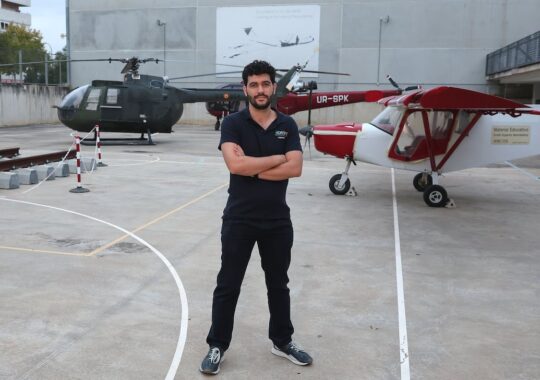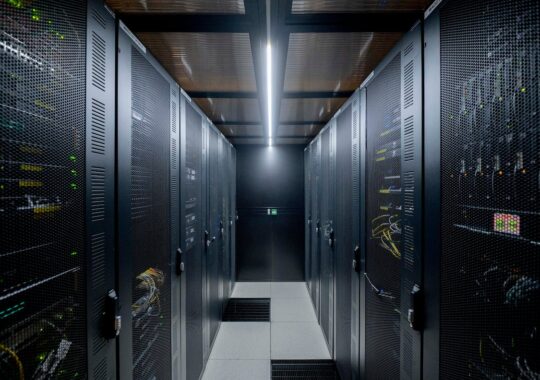“The next great leap for humanity will be the robots humanoids.” This is stated by Rev Lebaredian, vice president of Omniverse and Simulation Technology at the computer giant Nvidia. And he believes it will happen soon. He argues that machines lacked the brain that artificial intelligence (AI) based on large language models (LLM) can already provide. It is the step to physical AI, which has already started with vehicles, buildings, homes, health centerssurgical systems and even cities. The new robots are no longer simply “blind and dumb” articulated arms, as Lebaredian describes the old models, but they can understand, learn, perceive and act. “We are very close,” he says.
On the sidelines of the advertising show on the 11th for the Optimus robots from Elon Musk’s company Tesla, partially remote-controlled by humansthe serious race for this technology is in the hands of about twenty companies such as 1X Technologies (participated by Open AI), Apptronik, Agility Robotics, Figure (participated by Jeff Bezos, Open AI and Nvidia) or Boston Dynamics, among others.

Rev Lebaredian, who has participated in the double international meeting World Congress on Innovation and Technology y Digitec from Yerevan (Armenia), to which EL PAÍS has been invited along with a dozen international media, defends that the mechanical part of the humanoid is practically resolved and that the market will push for its lowering price, as has happened with other devices. “We now have the technology to build these physical robots and reduce their price to a few thousand dollars,” he explains. What was missing emerged a decade ago, when programming, in his words, “stopped generating tools to create skills, intelligence.” “It is a new revolution,” he warns.
He assures that “the scientific part of this is largely resolved.” “Now we are going to get into engineering to discover how to transform the basic technologies we have into a product,” he adds.
In this dizzying process, which the vice president of Nvidia considers close, although he does not venture to specify deadlines, one of the keys, he says, will be simulation, which he defines as “the training ground for these new robotic brains to test them and take them to the real world.”
David Yang, businessman and founder of the educational foundation Aybis also in this race. He is the creator of Morfeus.aiquadruped robots with learning and sensory capabilities, and what is considered the most extraordinary smart home in Silicon Valley, with multiple robotic functions.
Yang supports the forecasts of the Nvidia manager and specifies the deadlines: he defends that the “most exciting and spectacular revolution” will be consolidated in the next 10 years, “when artificial intelligence will exceed human capabilities”, especially in programming.
When this robotization is consolidated, there will still be aspects to define, such as responsibility for their actions. Lebaredian believes that it will be a regulatory issue outside of development and that, therefore, it will depend on each country, on the mechanized tasks, on the owner of the robot or its operator or its programmer. “We’re going to have to start figuring that out,” he admits.
Hrant Khachatrian, computer scientist at Yerevan State University and director of the machine learning laboratory, provides one of the keys for all developments to be involved in the society they serve: “There must always be a human behind it.”
In connection with the jobs they will replaceLebaredian is optimistic and assures that robotization will be implemented in areas where there is a lack of labor due to retirement or because there are not enough personnel for certain tasks, such as driving goods or logistics or caring for the elderly. “There are many jobs for robots that are now unfilled. We don’t have to worry so much,” he summarizes.
The manager warns that robots, which he defines as “anything that perceives, decides, plans and acts”, are already implemented and they act as computer agents or as taxis or as drones or in the pharmaceutical industry and even in surgery. But a qualitative leap is missing: the development of a general-purpose robot, “that can do many different types of tasks in spaces that are built for humans.”
This fundamental element accurate humanoidas Lebaredian explains: “Maybe he doesn’t need legs and moves on wheels, or he does, when he has to climb stairs. Maybe it has three arms instead of two. As we begin to build other spaces, especially factories and warehouses where there are no humans, we can hyper-optimize robots for those places. But we are going to have spaces for humans for a long time, most of the world, most of the factories, warehouses, hospitals, most of everything is designed for us, so this factor is really important and that is why we bet that “They will be humanoid.”
The next step will be home, daily life, medical care or dependent assistance. The computer expert predicts that it will be an unequal implementation and not only due to the economic capacity of each society. “Some cultures, like Japan, are more receptive. In the United States, the vision of a humanoid robot is still Terminator. There are cultural elements that come into play and we will have to see how consumers react and adapt to this,” he concludes.




